
Micropachycephalosaurus is an extinct genus of basal ceratopsian dinosaur containing only the type species, Micropachycephalosaurus hongtuyanensis It lived in China during the Late Cretaceous (Campanian) and was found in the Jiangjunding Formation.
Borealosaurus is a genus of titanosaurian sauropod dinosaur from the Late Cretaceous of northern China. The type species is Borealosaurus wimani, which was named in 2004.
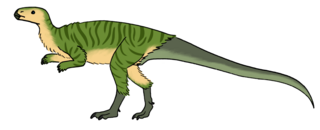
Changchunsaurus is an extinct genus of small herbivorous dinosaur from Early Cretaceous deposits of Gongzhuling, Jilin, China. It is the first named dinosaur genus from Jilin.
Gobititan is a genus of herbivorous sauropod dinosaur from the Aptian faunal stage of the Early Cretaceous. The name of this genus is derived from the Gobi desert region and the Titans of Greek mythology, which is a reference to its large body size. The specific name shenzhouensis, is derived from "Shenzhou", an ancient name for China.
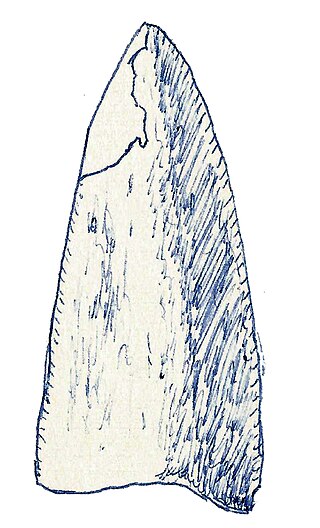
Mongolosaurus is a genus of titanosauriform sauropod dinosaur which lived during the Early Cretaceous of China.

Jiangshanosaurus is a genus of herbivorous titanosauriform sauropod dinosaur that lived in China approximately 92-88 million years ago, during the Turonian-Coniacian stage of the Late Cretaceous.

Nanshiungosaurus is a genus of therizinosaurid that lived in what is now Asia during the Late Cretaceous of South China. The type species, Nanshiungosaurus brevispinus, was first discovered in 1974 and described in 1979 by Dong Zhiming. It is represented by a single specimen preserving most of the cervical and dorsal vertebrae with the pelvis. A supposed and unlikely second species, "Nanshiungosaurus" bohlini, was found in 1992 and described in 1997. It is also represented by vertebrae but this species however, differs in geological age and lacks authentic characteristics compared to the type, making its affinity to the genus unsupported.
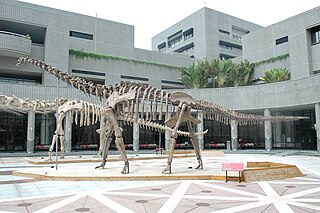
Huanghetitan, is a genus of sauropod dinosaur from the early Cretaceous Period. It was a basal titanosauriform which lived in what is now Gansu, China.
Fusuisaurus is a genus of sauropod dinosaur from the Early Cretaceous of China. Fragmentary postcranial remains of this animal have been discovered in 2001 in the Napai Formation of Guangxi, China and consist of the left ilium, left pubis, anterior caudals, most of the dorsal ribs and distal end of the left femur. This sauropod has been described as a basal titanosauriform.

Zhongyuansaurus is a monospecific genus of ankylosaurid dinosaur from Henan that lived during the Early Cretaceous in what is now the Haoling Formation. Zhongyuansaurus is possibly a junior synonym of Gobisaurus, a basal ankylosaurid from the Ulansuhai Formation of Inner Mongolia.
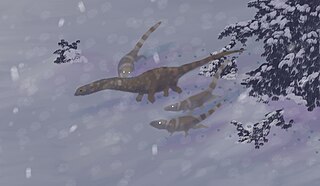
Dongbeititan is a genus of sauropod dinosaur from the Early Cretaceous-age Yixian Formation of Beipiao, Liaoning, China. It is based on holotype DNHM D2867, a partial postcranial skeleton including bones from the limbs, shoulder and pelvic girdles, and vertebrae, which was described in 2007. Its describers suggested it was as a basal titanosauriform, not as derived as Gobititan or Jiutaisaurus, but more derived than Euhelopus, Fusuisaurus, and Huanghetitan. The type species is D. dongi, and it is the first named sauropod from the Yixian Formation, which is part of the well-known Jehol Group. The genus name refers to the region Dongbei and to Greek titan, "giant". The specific name honours the Chinese paleontologist Dong Zhiming. Like other sauropods, Dongbeititan would have been a large quadrupedal herbivore.

Dongyangosaurus is a genus of titanosaurian sauropod dinosaur from the Late Cretaceous. The only species is Dongyangosaurus sinensis, from which only a single fragmentary skeleton is known, coming from the Zhejiang province of eastern China. It was described and named by Lü Junchang and colleagues. Like other sauropods, Dongyangosaurus would have been a large quadrupedal herbivore.

Ruyangosaurus is a genus of titanosauriform sauropod dinosaur recovered from the Early Cretaceous Haoling Formation of China. The type species is R. giganteus, described in 2009 by Lü Junchang et al.
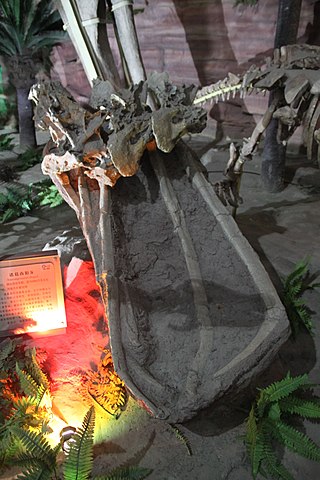
Baotianmansaurus is a genus of titanosaur sauropod dinosaur. Its fossils have been found in Upper Cretaceous rocks in Henan, China, within the Gaogou Formation. The type species is B. henanensis, described in 2009. The holotype is 41H III-0200. Remains of the fossils were vertebrae, ribs and scapula fragments. It was probably a close relative of Opisthocoelicaudia and Dongyangosaurus in Saltasauridae.

Qiaowanlong is a genus of sauropod dinosaur. Fossils belonging to the genus were found in 2007 from the Yujinzi Basin of Gansu, China, and were described in 2009 in the Proceedings of the Royal Society B. The remains come from a geological formation called the Xiagou Formation in the Xinminpu Group, dating to the Early Cretaceous. The only known specimen consists of articulated cervical (neck) vertebrae and a right pelvic girdle, as well as several unidentified bone fragments. Qiaowanlong was initially reported as the first brachiosaurid to have been found from China. However, later analysis found that it was more closely related to titanosauriformes like Euhelopus and Erketu. It is estimated to have had a length of around 12 metres (39 ft) and would have weighed around 6 tonnes. The type species is Q. kangxii.
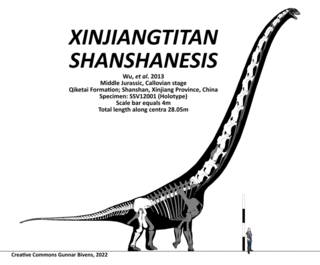
Xinjiangtitan is an extinct genus of mamenchisaurid sauropod that lived during the Middle Jurassic of what is now Xinjiang, northwestern China. Its type and only species is Xinjiangtitan shanshanesis, known from a single incomplete skeleton recovered from the Qiketai Formation. The holotype preserves one of the most complete vertebral columns of any sauropod found in Asia, and has the longest complete neck known for any animal.
Qijianglong is a genus of herbivorous mamenchisaurid sauropod dinosaur from the Early Cretaceous of China.
Liaoningotitan is a genus of titanosauriform sauropod from the Early Cretaceous (Barremian) Yixian Formation in Liaoning, China.























